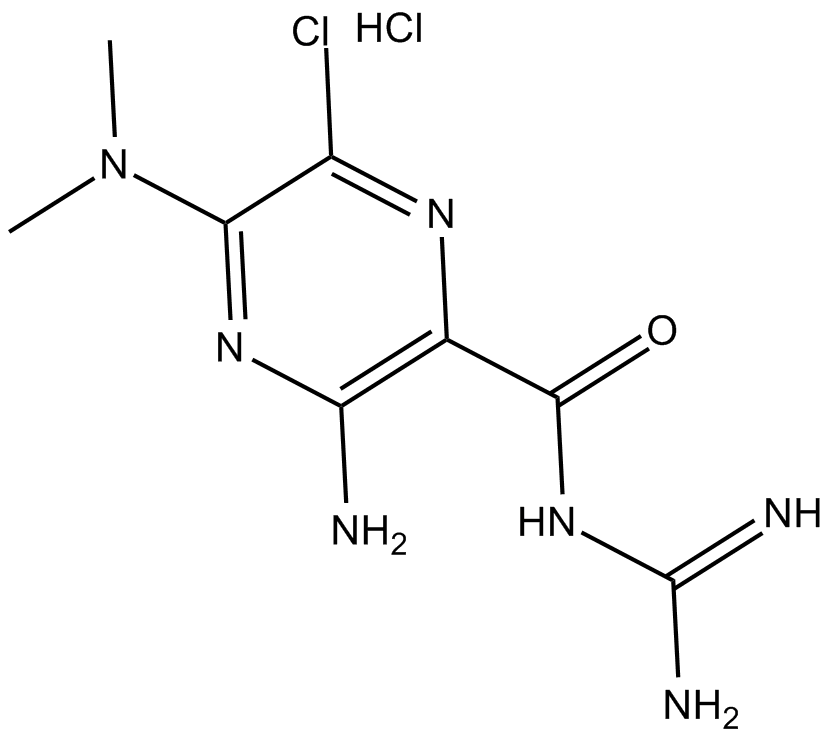5-(N,N-dimethyl)-Amiloride (hydrochloride) (Synonyms: DMA,L-591,605,MK-685) |
| Catalog No.GC10898 |
NHE1, NHE2, and NHE3 inhibitor
Products are for research use only. Not for human use. We do not sell to patients.

Cas No.: 2235-97-4
Sample solution is provided at 25 µL, 10mM.
5-(N, N-dimethyl)-Amiloride (hydrochloride), a derivative of amiloride, is an inhibitor of NHE1, NHE2, and NHE3.
The Na+/H+ exchanger (NHE) is a protein that has been involved in intracellular pH homeostasis of many mammalian cell types. NHE is involved in regulating intracellular pH and cell volume by extruding protons from, and taking up sodium ions into cells [1].
5-(N, N-dimethyl)-Amiloride (DMA) inhibited NHE1, NHE2, and NHE3 with Ki values of 0.02, 0.25, and 14 μM, respectively. DMA showed little or no effects on NHE4, NHE5, and NHE7 [1]. DMA could effectively protect the right ventricular wall against ischemia-reperfusion dysfunction in the presence or absence of ouabain [2]. DMA protected against severe reperfusion-induced cardiac contractile dysfunction, appeared to act via a normalization of tissue sodium levels [2]. DMA (0.2 mM) completely inhibited pHi recovery after cell acidification and blocked EGF-induced cytoprotection against acid [3].
In primary rat hepatocyte cultures and rat liver plasma membranes, DMA increased steady-state Na+ content and inhibited ouabain-sensitive 86Rb+ uptake in a reversible, concentration-dependent, ouabain-like manner, with estimated IC50 of 5.2×10-4 M. DMA also inhibited ouabain-sensitive ATP hydrolysis in rat liver plasma membranes with IC50 value of 2.2 ×10-3 M. DMA (10-3 M) decreased the uptake into hepatocytes of alanine by 61% [4].
References:
[1] Masereel B, Pochet L, Laeckmann D. An overview of inhibitors of Na+/H+ exchanger[J]. European journal of medicinal chemistry, 2003, 38(6): 547-554.
[2] Meng H, Pierce G N. Involvement of sodium in the protective effect of 5-(N, N-dimethyl)-amiloride on ischemia-reperfusion injury in isolated rat ventricular wall[J]. Journal of Pharmacology and Experimental Therapeutics, 1991, 256(3): 1094-1100.
[3] Fujiwara Y, Higuchi K, Takashima T, et al. Roles of epidermal growth factor and Na+/H+ exchanger-1 in esophageal epithelial defense against acid-induced injury[J]. American Journal of Physiology-Gastrointestinal and Liver Physiology, 2006, 290(4): G665-G673.
[4] Renner E L, Lake J R, Cragoe E J, et al. Amiloride and amiloride analogs inhibit Na+/K+-transporting ATPase and Na+-coupled alanine transport in rat hepatocytes[J]. Biochimica et Biophysica Acta (BBA)-Biomembranes, 1988, 938(3): 386-394.
Average Rating: 5 (Based on Reviews and 24 reference(s) in Google Scholar.)
GLPBIO products are for RESEARCH USE ONLY. Please make sure your review or question is research based.
Required fields are marked with *




















